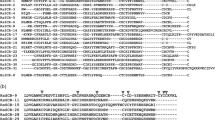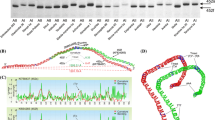Abstract
To extend the knowledge on the haplotype variability of the Bmy1 gene, region of the intron III was sequenced in a set of 20 Latvian accessions and Danish variety Maja, the data were compared to the previously reported allelic variants of the structural gene. Taking into account the polymorphisms of 59 loci and the microsatellite (MS) motif, 11 Latvian varieties turned out to have haplotype similar to cultivar Adorra, 1 – to Haruna Nijo, and 8 – to the newly described Abava Bmy1 intron III haplotype. High level of polymorphisms of (TG) m as well as (G) n component of MS was revealed for all the haplotypes studied. We conclude that the MS motif rather than the MS size length polymorphism correlates with mutations in the coding region of the β-amylase gene. Five graphical haplotype-specific intron III structures were constructed on the basis of the co-localization of the transcription factor binding sites (TFBSs), remnants of the transposable elements, and intron III polymorphic loci. Inter- and intrahaplotype variability was analyzed on the eventual functional significance of the Bmy1 intron III rearrangements. Novel data on the intron III nucleotide sequences of the Bmy1 gene were deposited in the GenBank (http://www.ncbi.nlm.nih.gov/) under accession numbers DQ316895–DQ316905.




Similar content being viewed by others
References
Eglinton JK, Langridge P, Evans DE (1998) Thermostability variation in alleles of barley β-amylase. J Cereal Sci 28:301–309
Erkkilä MJ, Ahokas H (2001) Special barley β-amylase allele in a Finnish landrace line HA52 with high grain enzyme activity. Hereditas 134:91–95
Erkkilä MJ, Leah R, Ahokas H, Cameron-Mills V (1998) Allele-dependent barley grain β-amylase activity. Plant Physiol 117:679–685
Fiume E, Christou P, Giani S, Beviarion D (2004) Introns are key regulatory elements of rice tubulin expression. Planta 218:693–703
Fu D, Szücs P, Yan L, Helguera M, Skinner JS, von Zitzewitz J, Hayes PM, Dubkovskii J (2005) Large deletions within the first intron in VRN-1 are associated with spring growth habit in barley and wheat. Mol Genet Genomics 273:54–65
Gazzani S, Gendali AR, Lister C, Dean C (2003) Analysis of the molecular basis of flowering time variation in Arabidopsis accessions. Plant Physiol 132:1107–1114
Gomez-Cadenas A, Zentella R, Walker-Simmons MK, Ho T-HD (2001) Gibberellin/abscisic acid antagonism in barley aleurone cells: site of action of the protein kinase PKABA1 in relation to gibberellin signaling molecules. Plant Cell 13:667–679
Gubler F, Kalla R, Roberts JK, Jacobsen JV (1995) Giberellin-regulated expression of myb gene in barley aleurone cells: evidence for Myb transactivation of a high-pI alpha-amylase gene promoter. Plant Cell 7:1879–1891
Kaneko T, Kihara M, Ito K (2000) Genetic analysis of β-amylase thermostability to develop a DNA marker for malt fermentability improvement in barley, Hordeum vulgare. Plant Breed 119:197–201
Kapranov P, Routt SM, Bankaitis VA, de Bruiji FJ, Szczyglowski K (2001) Nodule-specific regulation of phosphatidylinositol transfer protein expression in Lotus japonicus. Plant Cell 13:1369–1382
Kreis M, Williamson M, Buxton B, Pywell J, Heigaard J, Svendsen I (1987) Primary structure and differential expression of β-amylase in normal and mutant barleys. Eur J Biochem 169:517–525
Lewin B (2004) Genes VIII. Pearson, Prentice Hall
Lu CA, Ho T-HD, Ho S-L, Yu S-M (2002) Three novel MYB proteins with one DNA binding repeat mediate sugar and hormone regulation of α-amylase gene expression. Plant Cell 14:1963–1980
Ma YF, Evans DE, Logue SJ, Langridge P (2001) Mutations of barley β-amylase that improve substrate-binding affinity and thermostability. Mol Genet Genomics 266:345–352
Malisheva L, Ganal MW, Röder MS (2004) Evaluation of cultivated barley (Hordeum vulgare L.) germplasm for the presence of thermostable alleles of β-amylase. Plant Breed 123:128–131
Michaels SD, He Y, Scortecci KC, Amasino RM (2003) Attenuation of FLOWERING LOCUS C activity as a mechanism for the evolution of summer-annual flowering behaviour in Arabidopsis. Proc Natl Acad Sci USA 100:10102–10107
Paris M, Jones MGK, Eglinton JK (2002) Genotyping single nucleotide polymorphisms for selection of barley β-amylase alleles. Plant Mol Biol Rep 20:149–159
Plaschke J, Ganal MW, Röder MS (1995) Detection of genetic diversity in closely related bread wheat using MS markers. Theor Appl Genet 91:1001–1007
Polakova K, Laurie D, Vaculova K, Ovesna J (2003) Characterization of β-amylase alleles in 79 barley varieties with pyrosequencing. Plant Mol Biol Rep 21:439–447
Sheldon CC, Conn AB, Dennis ES, Peacock WJ (2002) Different regulatory regions are required for the vernalization-induced repression of FLOWERING LOCUS C and for the epigenetic maintenance of repression. Plant Cell 14:2527–2537
Sjakste T, Röder M (2004) Distribution and inheritance of beta-amylase alleles in North European barley varieties. Hereditas 141:39–45
Sjakste TG, Rashal I, Röder MS (2003) Inheritance of microsatellite alleles in pedigrees of Latvian barley varieties and related European ancestors. Theor Appl Genet 106:539–549
Van Wormhoudt A, Sellos D (2003) Highly variable polymorphism of the alpha-amylase gene family in Litopenaeus vannamei (Crustacea Decapoda). J Mol Evol 57:659–761
Wang HY, Lee MM, Schiefelbein JW (2002) Regulation of the cell expansion gene RHD3 during Arabidopsis development. Plant Physiol 129:638–649
Wullmout RL, Rushton PJ, Hooley R, Lazarus CM (1998) DNAase I footprints suggest the involvement of at least three types of transcription factors in the regulation of α-Amy2/A by gibberellin. Plant Mol Biol 38:817–825
Yanhui C, Xiaoyuan Y, Kun H, Meihua L, Jigang L, Zhaofeng G, Zhiqiang L, Yunfei Z, Xiaoxiao W, Xiaoming Q, Yunping S, Li Z, Xiaohui D, Jingchu L, Xing-Wang D, Zhangliang C, Hongya G, Li-Jia Q (2006) The MYB transcription factor superfamily of Arabidopsis: expression analysis and phylogenetic comparison with the rice MYB family. Plant Mol Biol 60:107–124
Yoshigi N, Okada Y, Sahara H, Tamaki T (1995) A structural gene encoding β-amylase of barley. Biosci Biotechnol Biochem 10:1991–1993
Yutzey KE, Kline RL, Konieczny SF (1989) An internal regulatory element controls troponin I gene expression. Mol Cell Biol 9:1397–1405
Acknowledgments
The study was supported by a grant from the Latvian Council of Sciences. Sequencing was performed by the Sequencing Service of the Biomedical Research Centre (Riga). We thank M. Bleidere for explanations on the malting quality of Latvian barley varieties and N. Sjakste for helpful discussion of the manuscript.
Author information
Authors and Affiliations
Corresponding author
Additional information
Communicated by F. Ordon
Rights and permissions
About this article
Cite this article
Sjakste, T.G., Zhuk, A.F. Novel haplotype description and structural background of the eventual functional significance of the barley β-amylase gene intron III rearrangements. Theor Appl Genet 113, 1063–1079 (2006). https://doi.org/10.1007/s00122-006-0366-3
Received:
Accepted:
Published:
Issue Date:
DOI: https://doi.org/10.1007/s00122-006-0366-3




